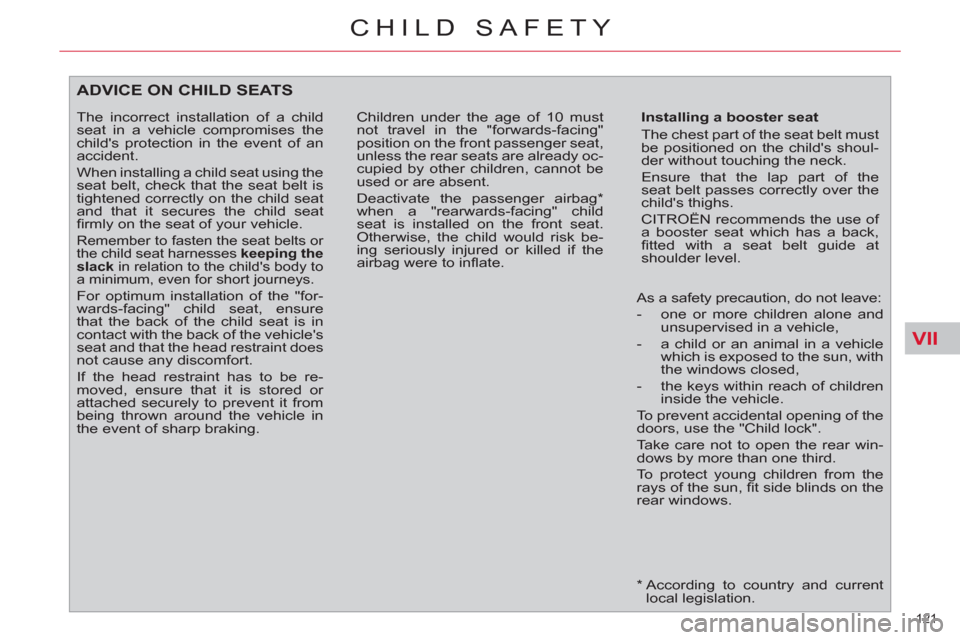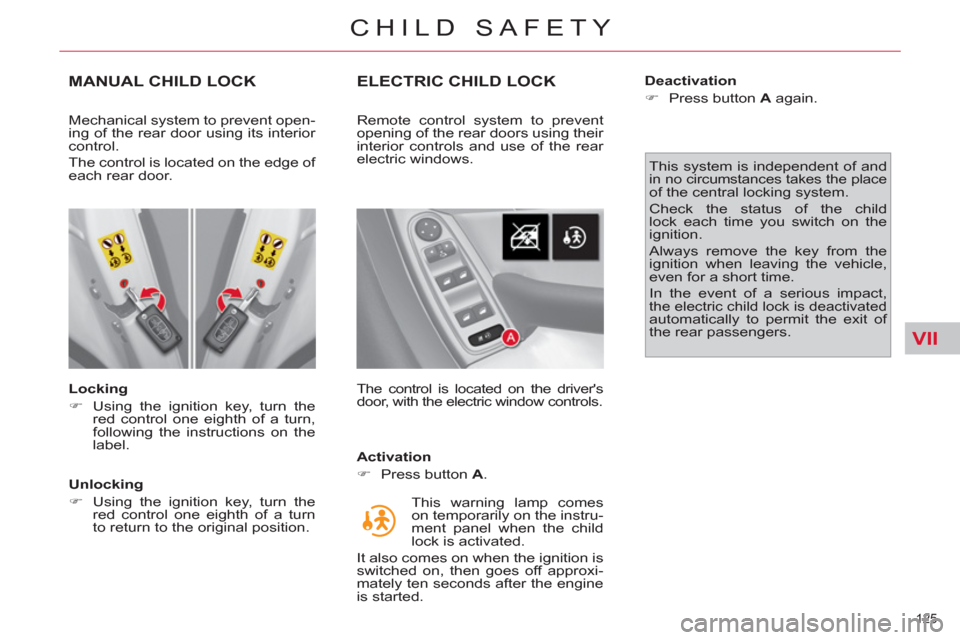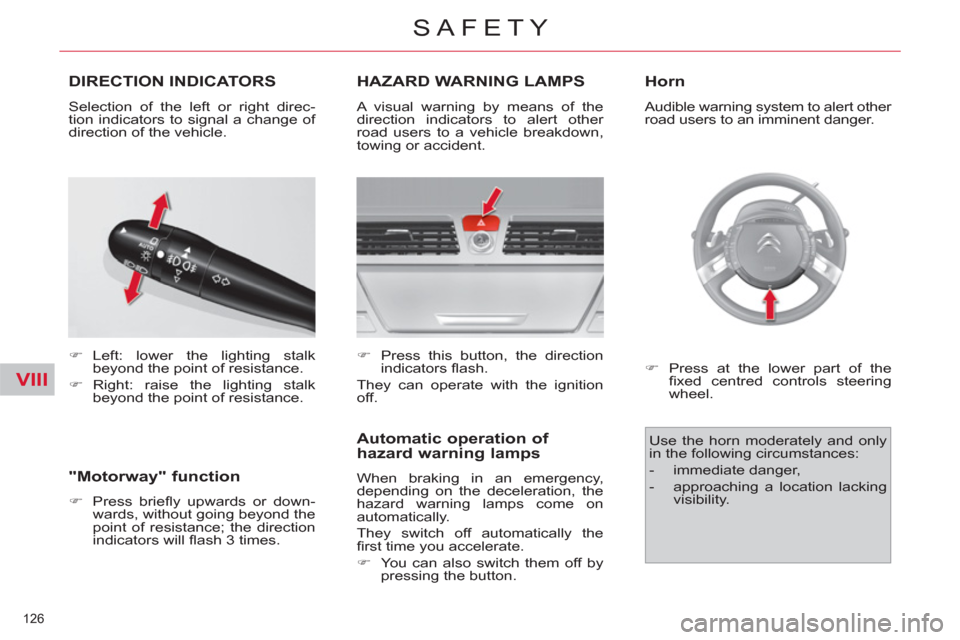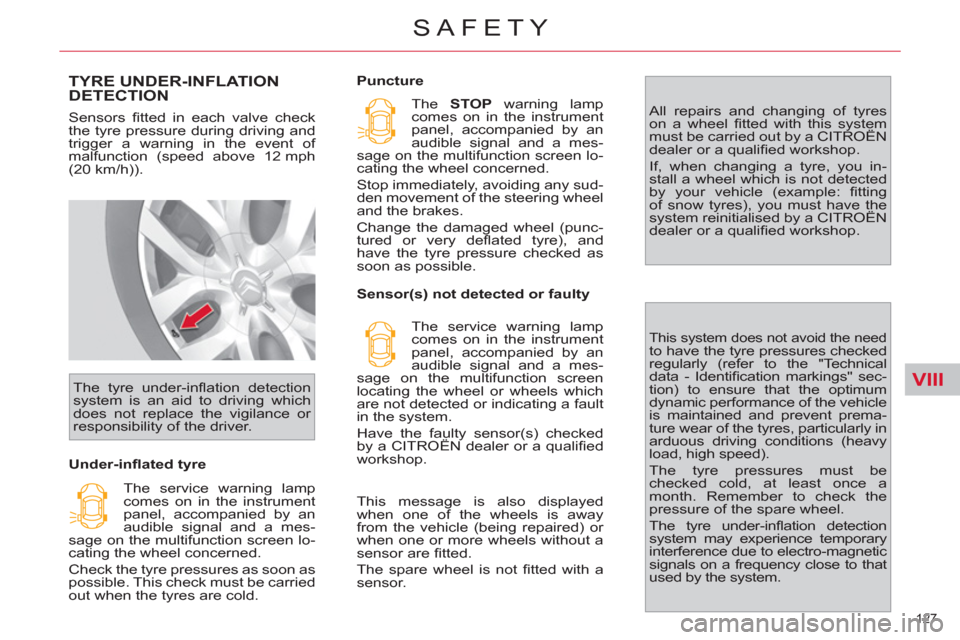Citroen C4 PICASSO 2011.5 1.G Owner's Manual
Manufacturer: CITROEN, Model Year: 2011.5, Model line: C4 PICASSO, Model: Citroen C4 PICASSO 2011.5 1.GPages: 352, PDF Size: 9.83 MB
Page 121 of 352

VII
11 9
CHILD SAFETY
CHILD SEATS RECOMMENDED BY CITROËN
CITROËN offers a complete range of recommended child seats which are secured using a three point seat belt
:
Group 0+: from birth to 13 kg
Groups 1, 2 and 3: from 9 to 36 kg
L1
"RÖMER Baby-Safe Plus"
Installed in the rearwards-facing
position.
L2
"KIDDY Comfort Pro"
The impact shield must be used
for carrying young children
(from 9 to 18 kg).
Groups 2 and 3: from 15 to 36 kg
L3
"RECARO Start''
L4
"KLIPPAN Optima"
From the age of 6 years
(approximately 22 kg), the booster
is used on its own.
L5
"RÖMER KIDFIX"
Can be fi tted to the vehicle's ISOFIX mountings.
The child is restrained by the seat belt.
Page 122 of 352

VII
120
CHILD SAFETY
*
Applies only to the CITROËN Grand C4 Picasso.
LOCATIONS FOR CHILD SEATS SECURED WITH THE VEHICLE SEAT BELT
In conformity with European law, this table tells you to what extent each of the seat positions in your vehicle may take a
child seat that is secured with the vehicle seat belt and approved as Universal (a), according to the weight of the child and
the position in the vehicle.
(a) Universal child seat: child seat which can be installed in all vehicles by means of the seat belt.
(b) Group 0: from birth to 10 kg. Shell seats and "car cots" cannot be installed on the front passenger seat.
(c) Consult the legislation in force in your country before installing your child on this seat.
U
: seat position suitable for the installation (in conjunction with the vehicle seat belt) of a universal rearwards-facing and/or
forwards-facing child seat.
For seats in groups 1, 2 and 3, check that the child seat is correctly secured on the backrest of the vehicle seat. If
necessary, remove and stow the head restraint.
To install a voluminous child seat in the 2nd or 3rd row, move the rear seat fully back so as to avoid interference with the
front seat.
Seat position
Weight groups established by legislation
< 10 kg and < 13 kg
(groups 0 (b) and 0+)
9 – 18 kg
(group 1)
15 – 25 kg
(group 2)
22 – 36 kg
(group 3)
1st
row
Front passenger
(c)
U
U
U
U
2nd row
Outer
U
U
U
U
Centre
U
U
U
U
3rd row
*
Outer
U
U
U
U
Page 123 of 352

VII
121
CHILD SAFETY
*
According to country and current
local legislation.
ADVICE ON CHILD SEATS
Installing a booster seat
The chest part of the seat belt must
be positioned on the child's shoul-
der without touching the neck.
Ensure that the lap part of the
seat belt passes correctly over the
child's thighs.
CITROËN recommends the use of
a booster seat which has a back,
fi tted with a seat belt guide at
shoulder level.
As a safety precaution, do not leave:
- one or more children alone and
unsupervised in a vehicle,
- a child or an animal in a vehicle
which is exposed to the sun, with
the windows closed,
- the keys within reach of children
inside the vehicle.
To prevent accidental opening of the
doors, use the "Child lock".
Take care not to open the rear win-
dows by more than one third.
To protect young children from the
rays of the sun, fi t side blinds on the
rear windows.
The incorrect installation of a child
seat in a vehicle compromises the
child's protection in the event of an
accident.
When installing a child seat using the
seat belt, check that the seat belt is
tightened correctly on the child seat
and that it secures the child seat
fi rmly on the seat of your vehicle.
Remember to fasten the seat belts or
the child seat harnesses keeping the
slack
in relation to the child's body to
a minimum, even for short journeys.
For optimum installation of the "for-
wards-facing" child seat, ensure
that the back of the child seat is in
contact with the back of the vehicle's
seat and that the head restraint does
not cause any discomfort.
If the head restraint has to be re-
moved, ensure that it is stored or
attached securely to prevent it from
being thrown around the vehicle in
the event of sharp braking. Children under the age of 10 must
not travel in the "forwards-facing"
position on the front passenger seat,
unless the rear seats are already oc-
cupied by other children, cannot be
used or are absent.
Deactivate the passenger airbag *
when a "rearwards-facing" child
seat is installed on the front seat.
Otherwise, the child would risk be-
ing seriously injured or killed if the
airbag were to infl ate.
Page 124 of 352

VII
122
CHILD SAFETY
"ISOFIX" MOUNTINGS
Your vehicle has been approved in
accordance with the latest ISOFIX
regulation s.
The three second row seats are fi tted
with regulation ISOFIX mountings. There are three rings for each seat:
- two rings A
, located between the
vehicle seat back and cushion,
indicated by a label,
- a ring B
, used to fi x the upper
strap, referred to as the TOP
TETHER
, indicated by a label
on a cover at the top of the seat
back. This ISOFIX mounting system pro-
vides fast, reliable and safe fi tting of
the child seat in your vehicle.
The incorrect installation of a child
seat in a vehicle compromises the
child's protection in the event of an
accident.
For information on installing ISOFIX
child seats in your vehicle, refer to the
table showing the locations that can
be used for ISOFIX child seats.
ISOFIX child seats
are fi tted with
two latches which are secured easily
on the two rings A
.
Some also have an upper strap
which is attached to the ring B
.
To attach this strap, remove the ve-
hicle seat's head restraint and the
cover at the top of the seat back.
Then fi x the hook on the ring B
and
tighten the upper strap.
Page 125 of 352

VII
123
CHILD SAFETY
This child seat can also be used on seats which are not fi tted with ISOFIX mountings. In this case, it must be attached
to the vehicle seat using the three point seat belt.
Follow the instructions for fi tting the child seat given in the seat manufacturer's installation guide.
RÖMER
Duo Plus ISOFIX
(size category B1
)
Group 1: from 9 to 18 kg
Installed only in the forwards-facing position.
Fitted with an upper strap to be secured on the upper ring B
,
referred to as the TOP TETHER.
Three seat body angles: sitting, reclining, lying.
�)
Adjust the front seat of the vehicle so that the child's feet do not touch
the back of the seat.
Page 126 of 352

VII
124
CHILD SAFETY
* The ISOFIX shell is secured to the bottom rings on an ISOFIX position, occupying 2 rear seat positions.
** To install ISOFIX child seats type B1
, remove the head restraints from the seats.
LOCATIONS FOR INSTALLING ISOFIX CHILD SEATS
In compliance with European legislation (ECE 16), this table indicates which of the ISOFIX child seats can be installed in
seat positions in your vehicle that are equipped with ISOFIX mounting points.
For ISOFIX universal and semi-universal child seats, the ISOFIX size class, defi ned by a letter from A
to G
, is shown on
the child seat to the right of the ISOFIX logo.
IUF : seat position suitable for installation of an I
SOFIX U
niversal " F
orwards-facing" seat attached using the top belt.
IL-SU
: seat position suitable for installation of an I
SOFIX S
emi- U
niversal seat: ISOFIX "rearwards-facing" child seats
equipped with a top belt and ISOFIX "shell" child seats with a top belt.
Do not install ISOFIX child seats equipped with a bar.
Child weight/age given as a guide
Less than 10 kg
(group 0)
Up to approx.
6 months
Less than 10 kg
(group 0)
Less than 13 kg
(group 0+)
Up to approx.
1 year old
9 to 18 kg (group 1)
From 1 to 3 years approx.
Type of ISOFIX child seat
Shell seat
*
"Rearwards-
facing"
"Rearwards-
facing"
"Forwards-facing"
ISOFIX size classes
F
G
C
D
E
C
D
A
B
B1
**
ISOFIX outer rear seats
IL-SU
IL-SU
IL-SU
IUF
ISOFIX centre rear seat
X
IL-SU
IL-SU
IUF
Page 127 of 352

VII
125
CHILD SAFETY
MANUAL CHILD LOCK
Locking
�)
Using the ignition key, turn the
red control one eighth of a turn,
following the instructions on the
label.
Unlocking
�)
Using the ignition key, turn the
red control one eighth of a turn
to return to the original position.
ELECTRIC CHILD LOCK
Mechanical system to prevent open-
ing of the rear door using its interior
control.
The control is located on the edge of
each rear door. Remote control system to prevent
opening of the rear doors using their
interior controls and use of the rear
electric windows.
Activation
�)
Press button A
.
Deactivation
�)
Press button A
again.
This system is independent of and
in no circumstances takes the place of the central locking system.
Check the status of the child
lock each time you switch on the
ignition.
Always remove the key from the
ignition when leaving the vehicle,
even for a short time.
In the event of a serious impact,
the electric child lock is deactivated automatically to permit the exit of
the rear passengers.
This warning lamp comes
on temporarily on the instru-
ment panel when the child
lock is activated.
It also comes on when the ignition is
switched on, then goes off approxi-
mately ten seconds after the engine
is started. The control is located on the driver's
door, with the electric window controls.
Page 128 of 352

VIII
126
SAFETY
DIRECTION INDICATORS
�)
Left: lower the lighting stalk
beyond the point of resistance.
�)
Right: raise the lighting stalk
beyond the point of resistance.
HAZARD WARNING LAMPS
A visual warning by means of the
direction indicators to alert other
road users to a vehicle breakdown,
towing or accident.
Automatic operation of
hazard warning lamps
When braking in an emergency,
depending on the deceleration, the
hazard warning lamps come on
automatically.
They switch off automatically the
fi rst time you accelerate.
�)
You can also switch them off by
pressing the button.
Horn
Audible warning system to alert other
road users to an imminent danger. Selection of the left or right direc-
tion indicators to signal a change of
direction of the vehicle.
�)
Press this button, the direction
indicators fl ash.
They can operate with the ignition
off.
�)
Press at the lower part of the
fi xed centred controls steering
wheel.
Use the horn moderately and only
in the following circumstances:
- immediate danger,
- approaching a location lacking
visibility.
"Motorway" function
�)
Press briefl y upwards or down-
wards, without going beyond the
point of resistance; the direction
indicators will fl ash 3 times.
Page 129 of 352

VIII
127
SAFETY
TYRE UNDER-INFLATION DETECTION
Sensors fi tted in each valve check
the tyre pressure during driving and
trigger a warning in the event of
malfunction (speed above 12 mph
(20 km/h)).
Under-infl ated tyre The tyre under-infl ation detection
system is an aid to driving which
does not replace the vigilance or
responsibility of the driver.
Puncture
The service warning lamp
comes on in the instrument
panel, accompanied by an
audible signal and a mes-
sage on the multifunction screen lo-
cating the wheel concerned.
Check the tyre pressures as soon as
possible. This check must be carried
out when the tyres are cold. The STOP
warning lamp
comes on in the instrument
panel, accompanied by an
audible signal and a mes-
sage on the multifunction screen lo-
cating the wheel concerned.
Stop immediately, avoiding any sud-
den movement of the steering wheel
and the brakes.
Change the damaged wheel (punc-
tured or very defl ated tyre), and
have the tyre pressure checked as
soon as possible.
Sensor(s) not detected or faulty
The service warning lamp
comes on in the instrument
panel, accompanied by an
audible signal and a mes-
sage on the multifunction screen
locating the wheel or wheels which
are not detected or indicating a fault
in the system.
Have the faulty sensor(s) checked
by a CITROËN dealer or a qualifi ed
workshop. All repairs and changing of tyres
on a wheel fi tted with this system
must be carried out by a CITROËN
dealer or a qualifi ed workshop.
If, when changing a tyre, you in-
stall a wheel which is not detected
by your vehicle (example: fi tting
of snow tyres), you must have the
system reinitialised by a CITROËN
dealer or a qualifi ed workshop.
This system does not avoid the need to have the tyre pressures checked
regularly (refer to the "Technical
data - Identifi cation markings" sec-
tion) to ensure that the optimum
dynamic performance of the vehicle
is maintained and prevent prema-
ture wear of the tyres, particularly in
arduous driving conditions (heavy
load, high speed).
The tyre pressures must be
checked cold, at least once a
month. Remember to check the
pressure of the spare wheel.
The tyre under-infl ation detection
system may experience temporary
interference due to electro-magnetic
signals on a frequency close to that
used by the system.
This message is also displayed
when one of the wheels is away
from the vehicle (being repaired) or
when one or more wheels without a
sensor are fi tted.
The spare wheel is not fi tted with a
sensor.
Page 130 of 352

VIII
128
SAFETY
BRAKING ASSISTANCE
SYSTEMS
Group of supplementary systems
which help you to obtain optimum
braking in complete safety in emer-
gency situations:
- anti-lock braking system (ABS),
- electronic brake force distribu-
tion (EBFD),
- emergency braking assistance
(EBA).
Anti-lock braking system
and electronic brake force
distribution
Linked systems which improve the
stability and manoeuvrability of your
vehicle when braking, in particular
on poor or slippery surfaces.
Activation
The anti-lock braking system comes
into operation automatically when
there is a risk of wheel lock.
Normal operation of the ABS may
make itself felt by slight vibration of
the brake pedal.
Operating fault
When braking in an emergency,
press very fi rmly without releasing
the pressure. If this warning lamp comes
on, accompanied by an au-
dible signal and a message
in the screen, it indicates a
malfunction of the anti-lock braking
system which could result in loss of
control of the vehicle when braking.
If this warning lamp comes
on, together with the STOP
and ABS
warning lamps,
accompanied by an audible
signal and a message in the screen,
it indicates a malfunction of the elec-
tronic brake force distribution which
could result in loss of control of the
vehicle when braking.
You must stop as soon as it is
safe to do so.
In either case, contact a CITROËN
dealer or a qualifi ed workshop.
When replacing wheels (tyres and
rims), ensure that they conform to
the manufacturer's recommenda-
tions.
Emergency braking assistance
System which, in an emergency,
enables you to obtain the optimum
braking pressure more quickly, thus
reducing the stopping distance.
Activation
It is triggered by the speed at which
the brake pedal is pressed.
The effect of this is a reduction in
the resistance of the pedal and an
increase in braking effi ciency.
When braking in an emergency,
press fi rmly without releasing the
pressure.